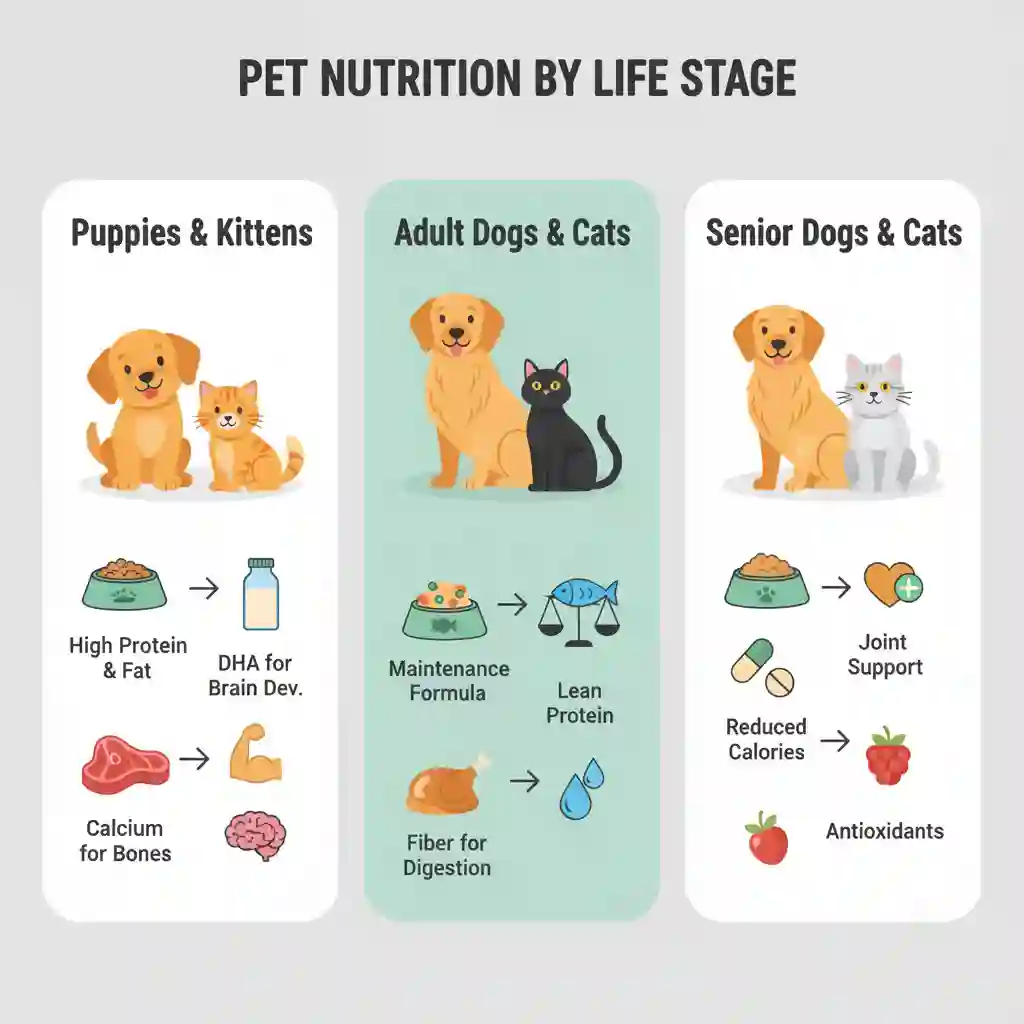Understanding Your Pet’s Unique Nutritional Requirements
Selecting the right food for your pet goes beyond brand names and marketing claims. As veterinary nutrition experts emphasize, proper pet nutrition requires understanding the fundamental biological needs of your specific companion. Dogs and cats have distinct nutritional requirements that differ significantly from human dietary needs, and these requirements further vary based on life stage, activity level, and health status.
The foundation of optimal pet nutrition begins with recognizing that cats are obligate carnivores, requiring higher levels of animal-based protein and specific nutrients like taurine, while dogs, as omnivores with carnivorous tendencies, need a balanced mix of protein, carbohydrates, and fats. This biological distinction forms the basis for all subsequent feeding decisions.
Decoding Pet Food Labels: A Scientific Approach
Learning to interpret pet food labels accurately is the first step toward making informed choices. Key components demand particular attention:
-
Ingredient List Analysis: Ingredients are listed by weight, but understanding their nutritional significance requires deeper insight. High-quality protein sources should appear first, with specific named meats (like “chicken” or “salmon”) rather than generic terms (like “meat by-products”). However, ingredient listing alone doesn’t reveal nutritional adequacy, making the guaranteed analysis crucial.
-
Guaranteed Analysis Understanding: This section provides minimum percentages of crude protein and fat, and maximum percentages of crude fiber and moisture. These numbers establish basic parameters but don’t reflect nutrient bioavailability or quality. More specialized pet foods may also include guaranteed levels of omega fatty acids, glucosamine, or other targeted nutrients.
-
Nutritional Adequacy Statement: This often-overlooked statement indicates whether the food provides complete and balanced nutrition for a specific life stage (growth, maintenance, or all life stages) as established by the Association of American Feed Control Officials (AAFCO) standards. This represents the most reliable indicator of a food’s basic nutritional completeness.
Life Stage Nutrition: Matching Food to Developmental Needs
A one-size-fits-all approach fails to address pets’ changing nutritional requirements throughout their lives:
-
Growth Formulations: Puppies and kittens require higher protein, fat, and specific mineral balances like calcium and phosphorus to support rapid development. These foods are specifically designed to fuel growth while supporting immune system development.
-
Adult Maintenance Formulas: Once pets reach maturity (typically 1 year for cats, 1-2 years for dogs depending on breed), their nutritional needs shift toward maintenance. These foods provide balanced nutrition without excess calories that could lead to weight gain.
-
Senior Pet Considerations: While no official AAFCO standard exists for senior pets, these formulations typically address age-related concerns through adjusted phosphorus levels for kidney support, joint health ingredients like glucosamine, and sometimes reduced calories to accommodate slowing metabolisms.
Special Considerations: Health Conditions and Dietary Solutions
Certain health conditions benefit significantly from targeted nutritional approaches:
-
Weight Management: Veterinary-recommended weight management foods typically feature reduced fat content, increased fiber for satiety, and precise calorie control. Portion control remains equally critical, with research indicating that nearly 60% of dogs and cats in developed countries are overweight, contributing to various health complications.
-
Food Sensitivities and Allergies: Pets with confirmed food allergies often require limited-ingredient diets or novel protein sources (like duck, venison, or kangaroo) to avoid triggering ingredients. Hydrolyzed protein diets, where proteins are broken down into sizes too small to trigger immune responses, represent another science-based solution.
-
Dental and Urinary Health: Specially formulated dental diets often have larger kibble sizes or specific textures that help reduce plaque and tartar accumulation. Urinary health foods are designed to maintain proper urinary pH and mineral balance, particularly important for cats prone to urinary crystal formation.

Implementing Optimal Feeding Practices
Beyond food selection, proper feeding practices significantly impact pet health:
-
Transitioning Foods: When changing your pet’s diet, implement a gradual transition over 7-10 days, slowly increasing the proportion of new food while decreasing the old. This gradual approach helps prevent gastrointestinal upset and allows your pet’s system to adapt.
-
Portion Control: Precisely measure food according to package guidelines based on your pet’s ideal weight, then adjust based on individual metabolism and activity level. Regularly assess your pet’s body condition score, aiming for a visible waist and easily felt ribs.
-
Treat Management: Treats should constitute no more than 10% of daily caloric intake to maintain nutritional balance. Consider incorporating portions of your pet’s regular kibble as treats, or select healthy, single-ingredient options.
Conclusion: Building a Foundation for Lifelong Health
Informed pet food selection represents one of the most significant contributions you can make to your companion’s long-term wellbeing. By understanding nutritional science, accurately interpreting labels, and implementing appropriate feeding practices, you provide the foundation for a vibrant, healthy life. Remember that individual pets have unique needs, and consultation with your veterinarian remains invaluable for addressing specific health concerns through nutrition.
Academic Reference
Supporting evidence for life-stage specific pet nutrition:
The Waltham Petcare Science Institute has conducted extensive research establishing distinct nutritional requirements for pets throughout their life stages. Their studies confirm that puppies and kittens have significantly higher requirements for specific nutrients including protein, calcium, and phosphorus to support optimal development, while senior pets benefit from adjusted nutrient profiles to support aging organs and maintain lean body mass.
Professional Disclaimer
Important Note: This article provides educational information about general pet nutrition principles. It is not intended to replace personalized veterinary medical advice. Always consult with your veterinarian for specific recommendations tailored to your individual pet’s health status, breed, age, and specific requirements, particularly when addressing medical conditions through dietary changes.

